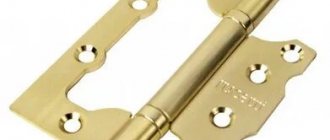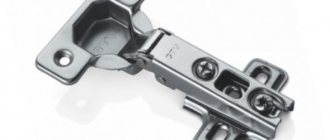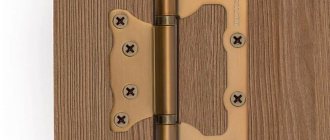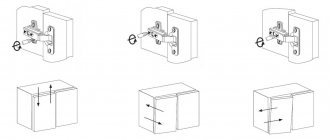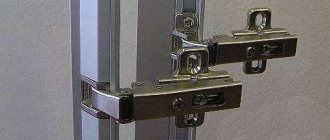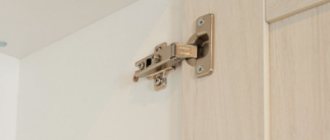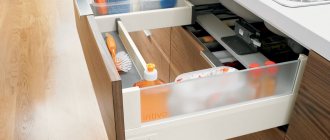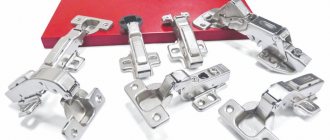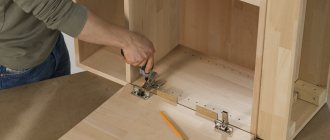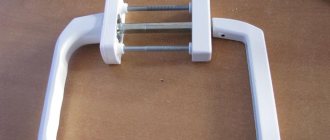Good day to all! It's time to talk about furniture hinges without inserts. Currently, buying such products is not a particular problem. Their price is quite low, but objective shortcomings make you think about whether they are worth buying.
The current range of furniture fittings is huge. Just take a look at what Leroy Merlin or Castorama has to offer.
All overhead furniture hinges can be divided into those that require insertion, that is, the use of a special drill for hinges, as well as simple fastening without preliminary recesses. The second option is easier in terms of do-it-yourself installation. But products without drilling have their obvious disadvantages.
Signs of classification
Awnings can be classified according to a number of defining characteristics:
- Installation location.
- Mechanism connector method.
- Type of attachment to the box.
- Material of manufacture.
- Type of construction.
It should be borne in mind that hinges are selected independently only for doors that are made of MDF or wood (see How to make wooden doors with your own hands - the best solution for any opportunity). Plastic, steel and aluminum products are supplied fully equipped with fittings and canopies.
The location of the hinges determines their type. They can be:
- For entrance structures. They have great strength and overall dimensions. In addition, such products must provide protection against the removal of the doors, which will become an additional obstacle to unauthorized break-in.
- For interior openings. These are simple designs that are lighter and more elegant.
Types: advantages and disadvantages
There is a wide variety of awnings. The main ones are summarized in the table:
| Advantages | Flaws |
| overhead element, types | |
|
|
| Hidden element | |
|
|
| End elements | |
| It is not recommended to heavily load the doors. |
| Mortise | |
| For their manufacture, ordinary steel is used, followed by the application of chromium or nickel. |
| Screw-in | |
|
|
| Corner canopy | |
| These are card canopies shaped like an angle. They have the same advantages. In addition - installation of a hinge on doors with a rebate. | The device cannot be hidden, which spoils the appearance. |
| Double sided canopy | |
| Possibility to open the canvas in two directions. This is very convenient for offices and catering establishments where there are large crowds of people. Otherwise, the products are called bar products. |
Susceptibility to shock loads. Distortion and jamming may occur. |
| Elements on bearings | |
| If the quality of the bearings is poor, the cages may crumble and the balls may fly apart. |
| Door piano products | |
| Such models are morally outdated and have been actively replaced by other types. |
For specific facades
For this purpose, special types of loops are used. Facades, the production of which uses an aluminum frame of various sizes, must be installed on reinforced hinges. They can be overhead or internal type. Used for corner cabinets. Open to different radii. When using overhead hinges, there is no need to perform additional drilling, which is important for these facades due to the thickness of their walls.
They are characterized by ease of installation, durability and practicality, and can serve for a long time even with intensive use.
Corner
This type of loops is in turn divided into 4 subtypes:
- 30 degrees. It has the ability to press the facade located at the appropriate angle. It can be used for beveled kitchen cabinets and wardrobes.
- 45°. Used for cabinets that have a specific shape. It is hung on a facade with 1 or 2 doors.
- 120 degrees. It can be seen on accordion cabinets. This is a special type of facade that can open 270 degrees.
- Furniture hinges with a negative opening angle. They are used in certain design projects in which it is necessary to open the last cabinet in a row from a certain side that is not usual for these models.
The main types of corner furniture hinges are with opening angles of 30 and 45, 60 and 90, and 135 degrees.
Shtolnaya
This type of hinge is quite popular in the interior when it is necessary to connect a false panel to a facade. The design characteristics will ensure that any door mechanism can be closed/opened silently. Can be fixed on folding forms of furniture elements. They can be used to fasten various parts on a folding structure, which will ensure their tilting 180 degrees.
Wall furniture hinges are suitable for fastening facades to false panels and racks located near the wall.
Piano
Used to form a straight line when connecting the door and side post. Possible rotation angle is 180 degrees. Most types of these hinges are used on built-in facades. Appearance: two perforated plates connected to each other.
Due to their strength and durability, piano hinges are ideal for installation on heavily used doorways.
Before going to the store
Before you go looking for door hinges, you need to clarify what features the door design has
Please note the following points:
- is there a porch;
- what is the weight of the canvas;
- how intensively the door will be used;
- in which direction the sash opens;
- width of the door leaf;
- what degree of burglary resistance is required to be ensured.
It remains to decide which loops to choose and in what quantity.
Material
Domestic and foreign manufacturers present models made of various metals and alloys, distinguished by special properties.
- Brass plated. The base is aluminum, zinc or steel alloys. The brass coating ensures easy movement of rubbing parts and protects them from corrosion.
- Brass. Strong and durable material easily withstands high loads and the impressive weight of the door leaf. They are produced in polished form or coated with chrome.
- Steel. The most durable products. Still, their price is appropriate. Therefore, installing them on interior walls is not always economical. In most cases, they are used for entrance groups.
Butterfly loop with rebate
Butterfly hinges for interior doors that are equipped with rebates are more reliable. This is reported by numerous reviews from masters. These loops have several variations. They are:
- Left;
- Rights;
- Universal.
The last one listed can be attached to any door, but with others it is more difficult. To understand which hinge to choose, you need to face the doorway: if the product should be attached to the left hand, then you need to buy “right” butterflies, and if on the right, then “left”.
Most often, hinges are made of brass or steel. Careless sellers may claim that their product is very reliable, but you should not take their words. It is worth choosing a hinge with a coating, which will additionally protect the item from corrosion.
For glass doors
Four-hinged hinges are used to connect the glass door to the facade. For such products, you will need to not only insert a high-quality device, but also a loop that has a beautiful external shape. The ability to open moving parts in three planes is one of the advantages of these hinges.
Hinges for glass doors are manufactured and installed taking into account the fragility of the material.
For glass in the design of the connecting device, a cup made of plastic material. There is a seal ring. On the visible side, you can choose a loop with a decorative plug. It can be semicircular or round in shape. Also currently on sale there are products with different colors.
According to the installation method, furniture hinges for glass doors are available with or without drilling.
The manufacturer of this type of product equips them with high-quality connections that can withstand a large number of opening/closing cycles. It is important that such furniture hinges have no defects and that they have an aesthetic appearance.
If the glass is darkened, you can choose a dark hinge. When selecting a specific facade, you can choose any of the types: internal, external, semi-overlay, screwless, self-closing, fastened at the desired angle.
Step-by-step instructions for installing door hinges with your own hands
Inserting hinges into doors requires preliminary preparation. Therefore, before starting work, it would be wise to stock up on the following tools:
- Stand for the door block;
- Assembly knife;
- Fraser;
- Template for router;
- Screwdriver;
- Chisel;
- Hammer;
- Simple pencil;
- Roulette;
- Construction level.
The optimal type of hinges for attaching the leaf to the door frame is pre-selected. The quality and duration of operation of the interior door structure will depend on the quality of the product.
At the same time, it is important to take into account which direction the sash is planned to open, because there are right and left hinges (detachable), universal
Universal hinges are suitable for all door blocks, regardless of which side they will open from. In this case, if it is necessary to remove the door leaf, you will have to dismantle the fastening elements themselves.
Next, you need to determine the parameters of the door structure itself in order to correctly calculate the number of canopies.
Mortise hinges, or more precisely the number of them required to secure the doors in the frame, are calculated according to the following criteria:
- Canopy map thickness. The thicker the loops, the better the quality of fastening, the less backlash and sagging of the canvas;
- Electroplating, polishing – uniform coating of the product, i.e. no chips, scratches or bulges;
- Alignment, pairing of individual elements. The product cards must be identical, ideally adjacent to each other;
- Fastenings with bearings instead of standard anti-squeak rings are characterized by high quality.
Inserting hinges involves preliminary marking of the place where they are attached to interior doors. To do this, you need to measure approximately 25 cm from the bottom and top from the edges of the canvas. Next, canopies are applied to the marked points and outlined with a simple pencil. The material is removed to perform hidden installation of the product.
Initially, one part of the fastening cuts into the door leaf, then the second into the frame of the interior block. In this case, the product is inserted with the logo facing up. This will allow the hinges to be installed correctly.
To make a high-quality removal of material from the door block for the installation of hidden fasteners, it is recommended to use a pre-prepared template and a professional milling machine.
Before starting work, the router must be adjusted to the required depth (to the thickness of the product card). And only after preliminary adjustment of the tool is the material sampled.
In the absence of special milling equipment, material is removed from the door leaf and frame in the standard way - using a hammer, chisel, or a sharp construction knife.
Using the hinge template, which was previously drawn on the surface of the door with a simple pencil, a cut is first made with a knife to the depth of the laminate or veneer. This will limit the movement of the chisel when removing material and ensure an even cut along the edges. In the formed frame, holes are also made with a chisel into the slot to the depth of the loop map.
All formed corners are additionally processed using an angular and straight chisel. The quality of the cut is checked. To do this, you need to place the fastener in the prepared recess; it should lie perfectly in it.
The next step is to make holes for screwing in self-tapping screws, with the help of which the awnings will be held on the door leaf. To do this, use an electric drill with a drill of a smaller diameter than the diameter of the screws themselves.
In a similar way, recesses for mortise hinges are made on the frame for interior doors. For the correct placement of holes for fasteners, the box must first be prepared. To do this, cuts are made at 45º. In this case, the height of the canvas and the required gap between it and the floor base must be taken into account.
Troubleshooting technologies
Under heavy loads, folding furniture breaks. You can do the table repair yourself. The volume and complexity of the work depends on the design. A regular type of framed table is not difficult to repair.
How to repair a hinge:
- Retractable mechanisms jam . Check the serviceability of the slides and guides.
- It is difficult to open, there is a grinding, squeaking sound . Lubricate the mechanism.
- The guides are bent/deformed . If you need new ones, dismantle them and install them in their original place.
- The sockets with screws in the chipboard have become loose. Unscrew the screw, fill the hole with sawdust, and fill it with wood glue. After drying, mount the part in the same place.
Distortion of the canvas due to the scattering of the fastening socket
How to choose accessories:
- To replace hinges and mechanisms, buy exactly the same one. Do not take an approximately similar part; it must exactly repeat the size and type of the previous mechanism.
- Check the quality of work on site! The movements of the mechanism must be without backlash. light and soft.
- The strength of the planks and mounting angles is checked for fracture. For example, you cannot bend metal with your hands.
- Cheap hinges won't last long!
You can prevent hinges from breaking by careful handling: do not exceed the permissible loads, and do not use physical force when unfolding.
How to adjust hidden door hinges
After installing the hidden hinges, you need to adjust them. This procedure may also be required due to the fact that the canvas sags during operation.
Hidden hinges are adjustable in three directions:
- Horizontally. To do this, use a hexagon to turn the adjusting screw located on the right side of the hinge at the top. Thus, the canvas is aligned on both sides relative to the box, and the adjustment amount is 1 mm.
- Vertically. To do this, you need to turn the adjusting screw; it connects the two hinge arms. This allows you to even out the gaps between the sash, the floor and the top of the box. The adjustment amount is 1.5–2 mm.
- By pressure. Using a hexagon, turn the eccentric located on the left side of the loop. Achieve uniform pressure of the sash to the frame along the entire perimeter. You can make an adjustment of 1 mm in one direction or the other.
After the hidden hinges have been adjusted, decorative trims can be installed.
Common causes of breakdowns
Hinges and guides can break due to intensive use, installation errors, dynamic loads, and defective fittings. Failure manifests itself in different ways:
- If the assembly is of poor quality , the connection point weakens and falls off.
- Careless handling can cause the screw inlet holes to become loose.
- Misalignment of the fittings causes jamming and wear of the mechanism.
- From adhesive spikes, the grooves often dry out, which leads to weakening of the fasteners.
Glass tables have a problem in the form of displacement of the thrust bearings, breakage of threads, peeling of adhesive joints.
It has been proven that tables with glued tenons and dowels are 60% more likely to break. Structures with bolts and screws do not break longer. The mechanisms held together by plates and iron corners “work” properly.
What to look for when choosing hidden door hinges
When choosing such products, you should pay attention not only to their cost, but also to their performance characteristics. It is better to buy fittings from trusted manufacturers such as AGB, Armadillo, Krona Koblenz and others
There is no need to try to save money by buying loops of dubious origin. Door hinges must ensure not only smooth and easy opening of the door leaf, but also reliable fixation to the frame
It is better to buy fittings from trusted manufacturers such as AGB, Armadillo, Krona Koblenz and others. There is no need to try to save money by buying loops of dubious origin. Door hinges must ensure not only smooth and easy opening of the door, but also reliable fixation to the frame.
The Italian company AGB is a well-known manufacturer of hidden hinges
There are no specific instructions for choosing the right hidden loops. To purchase accessories that meet your requirements, it is enough to determine the following parameters:
- Door opening side. There are right and left loops. You can buy universal models, but their strength is lower.
- Loop size. To do this, you need to decide on the weight of the canvas. If it is 15–25 kg, then hinges 7–8 cm long are sufficient, and when the door weight is 25–40 kg, then canopies 10 cm long must be installed.
- Number of loops. This indicator also depends on the weight of the door leaf. For lightweight structures, it is enough to install two hinges. If the canvas is heavy, then 3-4 canopies will be needed.
- Material. For heavy entrance doors, you need to purchase hinges made of steel or brass. They are more durable, but also expensive. For interior structures, you can use hinges made of tsamak alloy. Their strength is sufficient for reliable fixation of interior paintings, and the cost of such fittings is less than that of steel or brass.
What are they made of?
Furniture hinges are a safe fastening, so the main goal of the manufacturer is to give them the following qualities:
- strength,
- design,
- life time,
- resistance to deformation,
- softness of sliding,
- anti-corrosion properties.
Manufacturers make furniture hinges from high-quality steel and brass; there are parts coated with chrome (chrome).
Brass does not darken, it can be matte or shiny
Installation of bar hinges
The insertion of bar-type door hinges is carried out differently due to the design. The product consists of two spring canopies. The sash can open in any direction and then return to its original location.
To install bar hinges, the installation instructions require the following steps:
- The bar awnings come with a key. If it is not there, you can take a hexagon of a suitable size and loosen the tension of the springs.
- Markings are applied under the fastening plates at the end of the sash and the door frame.
- Installation involves mandatory selection of recesses. Without them, the gap between the canvas and the frame will be about 12 mm.
- The fittings are fixed with self-tapping screws.
Further actions are aimed at adjusting the springs. They can break, so you need to tighten them, but not overdo it. Tension is carried out with a screw clockwise. During the adjustment, check the smoothness of the door opening. If the spring is tightly tightened, the sash will be pulled tightly to the side. If the tension is weakened, the sudden closing of the door leaf will result in a blow to the frame due to the failure of the mechanism to operate in time. Spring compression is checked periodically during operation. Over time they weaken, requiring additional adjustment.
Anyone can install any type of canopy. Such specific fittings as bar hinges are usually used on doors in bars, shops and other public institutions. At home, such canopies are not in demand.
Description
Furniture hinges without mortise are a type of fittings that do not require milling on the surface of the door. These include both fastenings for quick installation and classic ones with permanent fixation. If a regular loop requires the selection of a special recess, completely ready-made structures are used here that can be easily installed on top of the canvas.
Overlays are useful where the thickness of the material is too thin to require additional milling.
In the context of continuous furniture assembly, such fittings provide significant savings in time spent on performing the necessary technological operations. In addition to overhead hinges, there are other types of hinges that do not require insertion.
Making markings on the door frame
Before marking, hang the door leaf on wedges, not forgetting to leave the necessary gaps: 2-3 mm from the top, floor, left and right sides. Check the correctness of temporary fixation using a building level.
To install the “wing” of the overhead loop, just step back 20-25 cm from the top and bottom and make a mark. Using a building level, draw a line parallel to the floor and perpendicular to the jamb. Already attach a “wing” to it, circle it with a pencil. Then, focusing on the markings, attach the element and fasten it with self-tapping screws.
As for the mortise ones, they make a selection inside the contour using a chisel and a hammer. Its depth is the thickness of the “wing”.
To make your task easier, you should adopt the following rules:
- Install the lock in advance and close the door, which is currently on wedges, on it.
- Do not forget to check the temporary fixation of the door using a building level - there should be no deviations either horizontally or vertically.
- Make a temporary screwing of the hinge to the jamb: then remove it to trace the second “wing” on the canvas.
- When sampling, carefully monitor its depth: if there is a discrepancy, the alignment will skew in the future.
Questions and answers about butterfly loops
| Question | Answer |
| After installation, the door squints or does not close tightly, what does this mean? | This means that the hinges are screwed with a deviation from the common central axis, which runs along the rod of the awnings. You need to take a plumb line, find out which loop is skewed and remount it. |
| Is it true that fabric on butterfly hinges sags over time? | Provided proper installation, canvases weighing up to 20 kg are not in danger of sagging. If the weight is close to the upper limit of 30 - 40 kg, then for insurance you can attach 3 or even 4 canopies to one canvas. |
| Is it possible to hang solid wood doors on butterfly hinges? | Highly undesirable. The weight of the wooden panel starts from 35 kg and can reach up to 80 kg; with a high degree of probability, such doors will sag. |
| How good are butterfly hinges with bushing rings instead of bearings? | If the canvas weighs up to 15 kg, then it can be safely mounted on hinges with bushing rings; they are 30–40% cheaper than models with bearings. |
| Why is the outer part of the butterfly attached to the box, and the inner part to the canvas? | The outer card is wide and the holes go along the perimeter; therefore, when screwing a self-tapping screw into the very edge of the canvas, there is a possibility of delamination or cracks. |
Table repair
A few recommendations will help many to repair the table themselves.
- The connecting supports of the tabletop have become loose . Take a piece of fabric (wood, leather), seal the fastening groove and tighten the fasteners.
- The fittings are broken. Cannot be repaired - replace with a new one.
- The fastening of a folding table often breaks out . Place the hinge/mechanism nearby in a suitable location. Installation in old grooves leads to distortion of the tabletop, loosening of the mechanism and failure.
- The sliding mechanism does not work. If the rollers break, they cannot be restored - buy a set of new guides.
- The adhesive joint has become loose. A card table with a glass top often loses its adhesive bond. UV curing glue will restore the fasteners.
Overhead hinges: features and installation
They belong to the card type of loops and consist of two plates and a hinge. When open, the plates resemble butterfly wings, and when closed, one “wing” fits into the hole in the second half of the canopy. Thus, one plane is obtained, which becomes invisible. They are easy to install and do not require removal of wood from the door structure.
It is better to choose the color of the hinges in the same tone as the door handles
Installation requires precise selection of screws. The screws must be hidden in special grooves in the plates. Properly selected fittings will not interfere with the sash closing.
There are two versions of awnings available: on the door with a rebate and classic. The first design provides a bend in the plate, which ensures that the door closes tightly.
Advantages of plates:
- have an aesthetic appearance;
- do not require special tools for installation work;
- The rotating mechanism practically does not break.
Butterfly hinges are not ideal mechanisms and have their drawbacks.
Disadvantages of awnings:
- fastenings are designed only for perfectly flat surfaces;
- low-quality metal material contributes to the deformation of the product under the weight of the door;
- It is impossible to remove the door from the awnings. Only by unscrewing the screws is it possible to replace the blade.
Correct installation of hinges without insertion
Today, non-mortise fastening remains in demand among consumers, which means that step-by-step instructions for installing canopies without forming a groove will make this process accessible to everyone.
To hang the sash on the doorway, the appropriate fittings are selected. Traditional hardware products include butterfly hinges.
To complete the work you will need the following tools:
- stationery knife;
- drill or screwdriver;
- self-tapping screws;
- drill.
Installation technology:
- Marking.
First you need to determine the location where the mount will be installed. It is mounted on all sashes in the same way: from the extreme cut in the lower and upper parts of the leaf at a distance of 200 ─ 250 mm. Marking of the extreme holes is done with an awl. Using a tape measure, we mark the starting point of attachment. Mark the places where the self-tapping screws are screwed in. To do this, use an awl, since using a pencil will give you a fuzzy look. We use it to push through the point from which the self-tapping screw will no longer move to the side. First, the upper and lower points are outlined. If the loop shifts, the middle holes will correct the master's mistake. - Attaching the hinge to the door leaf.
It is not recommended to immediately screw screws into the product. First you need to drill shallow holes in the places for the screws. Use a drill with a diameter 1 mm smaller than the diameter of the self-tapping screw. If the diameter of a standard self-tapping screw is 3.5 mm, then a drill with a diameter of 2.5 mm is used for the hole. The canopy is applied and the self-tapping screws (top and bottom) are screwed in. The striker folds down. The gaps between the edges of the fastening and the blade must be the same. Checking the gaps between the hinge and the blade: they must be the same. If an installation error occurs, one self-tapping screw must be unscrewed and the hinge adjusted. Then the correction occurs using the middle holes. For the middle self-tapping screw, we also drill a hole into which the screw is driven. We make sure that the canopy is strengthened correctly and continue to drive the remaining screws into the holes. - Markings on the box.
It is better to install awnings when the frame is not yet installed in the doorway. But if this has already happened, then the installation of hinges on interior doors is done using wedges-stands. If everything is compatible, we move on to the next stage of work. We make marks of the canopies on the box. In places with arrows we make marks with a pencil. The loop should fit closely to the box. We remove the canvas to the side. - The butterfly hinge is attached to the door leaf with a small gap, and should be attached tightly to the frame.
- We apply and push through the outer holes with an awl.
- We drill holes for the screws and screw them in.
- We check the work for errors. If they are not found, then screw in the remaining screws.
Properly installed hinge
Assembly tools
The installation kit includes many tools:
- roulette,
- pencil,
- square,
- awl,
- hexagon,
- screwdriver,
For mortise hinges, round holes are made with a milling cutter
For marking, it is better to use a carpenter's pencil or an ordinary medium-hard one. This type of stylus is easily removed and does not leave marks on the facade of the furniture.
Advantages of hidden hinges
Surely you chose to install hidden hinges for a reason, and this is the right choice. Here are the qualities you can use after installing the hinges:
- Absolute safety. Even with all their desire, intruders will not be able to enter your home by cutting off the hinges, since hidden-type products are hidden from outside interference.
- High strength. Hidden hinges can support the weight of not only wooden, but also heavy metal entrance doors - no restrictions on installation.
- Decent reliability. With proper care, standard hidden-type hinges will last you for many decades - perhaps even longer than the door itself.
- Aesthetics. Hidden hinges cannot be seen from the outside of the door, making door leaves look more attractive, especially for wooden ones.
Aesthetic appearance of hinges
Now that you are sure that your choice is correct, you can prepare to install hidden door hinges.
Other types of furniture hinges
Card, piano, and hinge hinges are rarely used for installing cabinet doors. They do not have three-level adjustment and do not lock the door in the open and closed position. An additional fastener is needed. Today they are more often used as an additional decorative element. For example, antique.
For installation of horizontal overhead panels that open upwards.
Mezzanine
Secretaries
Used for hanging downward opening facades.
Secretary room
We have learned in our practice how proper installation and adjustment of hinges affects the operation of the cabinet as a whole. Some time after assembly, the door of the wardrobe or kitchen cabinet stopped closing - the upper part of the door rested on the frame.
To correct the misalignment and use the cabinet normally, I had to readjust all the hinges. Therefore, during installation, it is advisable to prevent any deviations; any gap can lead to deformation of the entire cabinet structure.
